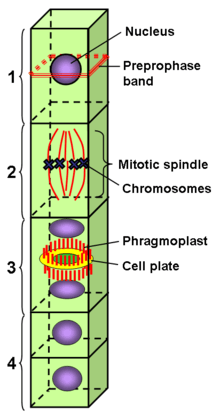Preprophase band

The preprophase band is a microtubule array found in plant cells that are about to undergo cell division and enter the preprophase stage of the plant cell cycle. Besides the phragmosome, it is the first microscopically visible sign that a plant cell is about to enter mitosis. The preprophase band was first observed and described by Jeremy Pickett-Heaps and Donald Northcote at Cambridge University in 1966.[1]
Just before mitosis starts, the preprophase band forms as a dense band of microtubules around the phragmosome and the future division plane just below the plasma membrane. It encircles the nucleus at the equatorial plane of the future mitotic spindle when dividing cells enter the G2 phase of the cell cycle after DNA replication is complete. The preprophase band consists mainly of microtubules and microfilaments (actin) and is generally 2-3 µm wide. When stained with fluorescent markers, it can be seen as two bright spots close to the cell wall on either side of the nucleus.
Plant cells lack centrosomes as microtubule organizing centers. Instead, the microtubules of the mitotic spindle aggregate on the nuclear surface and are reoriented to form the spindle at the end of prophase. The preprophase band also functions in properly orienting the mitotic spindle, and contributes to efficient spindle formation during prometaphase [2]
The preprophase band disappears as soon as the nuclear envelope breaks down and the mitotic spindle forms, leaving behind an actin-depleted zone. However, its position marks the future fusion sites for the new cell plate with the existing cell wall during telophase. When mitosis is completed, the cell plate and new cell wall form starting from the center along the plane occupied by the phragmosome. The cell plate grows outwards until it fuses with the cell wall of the dividing cell at exactly the spots predicted by the position of the preprophase band.
Bibliography
- P.H. Raven, R.F. Evert, S.E. Eichhorn (2005): Biology of Plants, 7th Edition, W.H. Freeman and Company Publishers, New York, NY, ISBN 0-7167-1007-2
- L. Taiz, E. Zeiger (2006): Plant Physiology, 4th Edition, Sinauer Associates, Inc., Publishers, Sunderland, MA, ISBN 0-87893-856-7
Notes and references
- ↑ Pickett-Heaps JD, Northcote DH (1966). "Organization of microtubules and endoplasmic reticulum during mitosis and cytokinesis in wheat meristems". Journal of Cell Science. 1 (1): 109–120. PMID 5929804.
- ↑ Ambrose JC, Cyr RJ (2008). "Mitotic spindle organization by the preprophase band". Molecular Plant. 1 (6): 950–960. doi:10.1093/mp/ssn054. PMID 19825595.